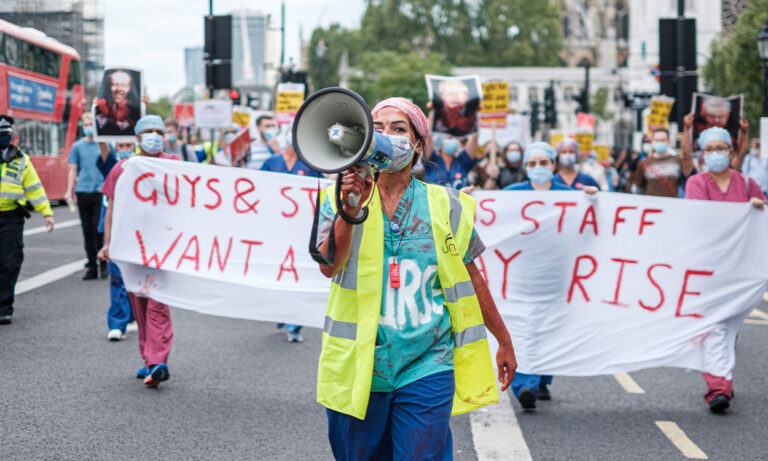Industrial action is at an all time high: What would happen if we all went on strike?
It’s 2023, and striking is in the air. From university lecturers to nurses, the UK is witnessing the largest surge in industrial action in recent memory, with the highest number of work days lost to strikes since the Thatcher era.
Can you blame them? Workers across the UK are feeling the squeeze, as pay growth suffers one of its largest falls since records began. So, why exactly do we strike? And what would happen if we all collectively hung up our boots and just… went on strike?
Why do we strike in the first place?
According to Dr Harry Pitts, senior lecturer in politics at the University of Exeter: “Strikes can be moments of political awakening, moments of solidarity, and moments of envisioning a better future of work on the picket lines.”
Speaking with SCREENSHOT, the lecturer continued: “But, ultimately, they are part of negotiations: the push and pull between employers and employees to find what’s usually a compromised solution to a dispute, where neither side gets exactly what they want in the beginning.” “That’s a very dispassionate way of seeing a strike—but it’s what we’re seeing now,” Pitts added.
When it boils down to it, striking is a vital tool that workers can use to manoeuvre themselves into a place of power against their employers. By stopping production and services, or simply just walking out of the job, they can leverage the power they have in an attempt to negotiate with the boss. As the cost of living crisis bites and inflation continues to rise, more workers across the UK are demanding fairer pay and rights within the workplace—something that’s absurdly become a luxury these days.
And, given the current climate, walking out of the job and heading for the picket line might be a tempting idea. Which begs the question: what would happen if we all went on strike?
So, can we all just go on strike?
The idea of widespread industrial action isn’t new. In fact, the most notable and largest industrial dispute in Britain’s history was the General Strike of 1926, in which workers across Britain stopped working in support of the coal miners who were facing severe cuts in pay, longer hours and devastatingly dangerous working conditions.
Given the increasingly heated tensions between employers and employees—and the serious criticisms surrounding Rishi Sunak and the current government— it wouldn’t be the most far-fetched assumption that we might be heading into another general strike, almost a century later?
Well, according to the experts, it isn’t that simple. Pitts explained: “I personally think it’s quite hard to imagine how it would happen in the UK today. It would be a totally different model than what we experienced in 1926.”
Why is that? In essence, it all boils down to how industry and work have changed over the last century. As the lecturer noted, unions simply don’t have as much power as they did in the early 1990s—in part due to the vast structural and societal shifts.
“Back then, you had high employment and also high trade union membership in industries like mining, so you could really cause a lot of chaos. You could really leverage your opposition as a union or group of workers,” Pitts stated.
“We have quite a different economy now which doesn’t tend to have that sheer industrial strength,” he continued.
Although numbers fluctuate slightly year on year, the past decades have seen a fall in trade union membership across Britain—with the balance of power shifting decisively towards employers. According to research by the Resolution Foundation and the London School of Economics, union membership in 2021 had fallen to 23 per cent, down from a peak of 53 per cent in 1980.
What’s this resulted in? A serious blow to the pocket of the everyday British employee. According to the 2022 study, the decline in trade unions has caused UK workers to be £100 a week worse off in wages, with earnings marked down as much as 25 per cent.
The reality of striking in 2023
The reality is that we’re sadly not in a position to call for a general strike, or at least widespread industrial action reminiscent of what we’ve seen in the 1920s. Looking at the numbers is somewhat of a reality check, but that doesn’t mean it’s not important to pick up the pickets.
There “isn’t any serious proposal” for a general strike, Pitts reinforces. Instead, when people do call for a general strike, industrial activists usually refer to some sort of coordinated action between sectors that are considering a strike or are currently striking—university lectures, postal workers, train staff, and so on.
“[The term today often refers to] the idea that you can’t coordinate that action to bring society to a standstill, to better realise the different conditions that people are fighting for,” Pitts said. “If that were to happen, it would probably be done through the Trade Union Congress, which brings together many of Britain’s trade unions under one roof.”
The lecturer concluded that, while this specific body hasn’t coordinated any action, there have been some forms of collaboration in recent times. Such as the university staff striking on the same days as railways workers and nurses, for example.
In other words, this is a recent overt example of collaboration and solidarity between different sectors, a taster of what a general strike could look like. But we’re far from implementing a general strike across the country.
At face value, a general strike can seem like an ambitious and, depending on who you ask, exciting prospect. It can represent a middle finger to the greedy elite, and a demand for better fairer working conditions. But dig a little deeper and the reality of a general strike is a lot more complicated.
From the weakening power of trade unions across Britain, to the drastic changes we’ve seen in the industry over the last century, it’s clear that a general strike isn’t going to happen anytime soon. But that doesn’t mean striking is meaningless either.
As gen Z continues to face the transformative ways in which we work—feeling the brunt of zero-hour contracts, the gig economy and precarious forms of labour—trade unions have never been more important for young people.
So, even if we’re not heading for a general strike, it’s important to fight for your rights to fair work and join a union. After all, we wouldn’t have a minimum wage, holiday pay, or even the weekend without them.






